Jardin des Plantes
Medicinal Garden of the King
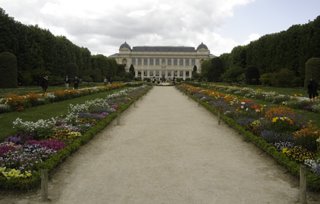
Jardin des Plantes
Metro: Jussieu
RER: Gare d'Austerlitz
Arrondissement: 5eme
Go Here For Hotels In This Area
Map of the Area
The Jardin des Plantes, the Garden of Plants, is the main botanical garden in France. It is situated in the 5th arrondissement, on the left bank of the Seine river and covers almost 24 hectares, 235,000 square meters.
The idea for a garden of medicinal plants for use and for research was put to Louis XIII in 1626 by botanist Jean Hérouard, the premier doctor to the king. The garden was planted in 1633 by Guy de La Brosse, also a doctor. It was originally known as the Jardin du Roi, Garden of the King.
It opened to the public in 1640.
The Comte de Buffon was the curator from 1739 until his death in 1788. He expanded the garden and added a maze, the Labyrinth, at the top of a small hill, which is there today.
The Musée National d'Histoire Naturelle, The National Museum of Natural History, is situated within the Jardin des Plantes.
It is made up of four galleries: the Grand Gallery of Evolution, the Mineralogy Museum, the Paleontology Museum and the Entomology Museum.
In addition to the gardens there is also an aquarium and a small zoo.
The Jardin des Plantes maintains a botanical school which creates demonstration gardens and exchanges seeds to maintain biotic diversity.
About 4,500 plants are arranged by family groupings on a one hectare, 10,000 square meter, plot.

Three hectares of the Jardin des Plantes are devoted to horticultural displays of decorative plants, including a beautiful Iris Garden. An Alpine garden has 3,000 species with world-wide representation.
Specialized buildings, such as the Orangerie and the Mexican and Australian hot-houses, present regional plants not native to France.
The Mexican and the Australian green-houses of the Jardin des Plantes were built between 1834-1836 by Charles Rohault de Fleury. The use of glass as a building material was a true innovation of the time.
The Rose Garden of the Jardin des Plantes has hundreds of species of roses.

At the main entrance to the Jardin des Plantes is a large bronze statue of Jean-Baptiste de Monet de Lamarck, created by Léon Fagel in 1908. On it is written, "To the Founder of the Doctrine of Evolution".
It was not Darwin who founded the theory of evolution. What Darwin offered was the theory of natural selection, the method by which evolution occurs.
Scientific circles had been discussing evolution for some time before Darwin. In fact, Lamarck first expressed his theory of evolution in 1800.
To the left, east, of this statue of Lamarck is the Galeries d'Anatomie Comparée et de Paléontologie.
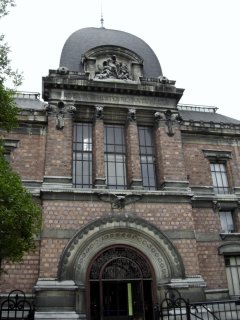
The Galleries of Compared Anatomy and of Paleontology are open Monday-Friday (closed on Tuesday) from 10 a.m.-5 p.m. and until 6 p.m. on Saturday and Sunday.
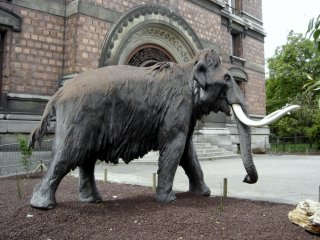
Admission fees are: 6 euros for adults, this ticket offers dicount entrance fees to all the other venues in the Garden for up to 3 months; 4 euros for those under 14 years old and for students under 26 years old and for groups of 10 or more, and free admission for those under 4 years old and for handicapped persons and their companion.
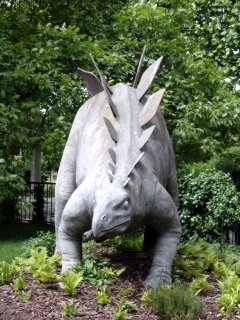
Behind the statue of Lamrack are stretches of a series of green lawns. An incredible number of plants are planted in these lawns, all labeled and tagged naming the species and the varieties of the plants.
On the left side of the Garden and behind the Gallery of Anatomy and Paleontology is a small carousel and a snack stand.
Directly west from here, across the lawns, is the Ecole de Botanique Jardin Alpin, the Botanical Alpine Garden School. The Alpine Garden was created in 1931, covering 4,000 square meters with more than 2,000 species of plants from the Alps, the Pyrenees, Greenland and the Himalayas.
The grounds here are gated. Public access is allowed Monday-Friday from 8 a.m.-4:50 p.m. It is closed on holidays and there is no admission fee.
Continuing westward you will come to the Jardin des Plantes Ménagerie, one of the world's oldest zoological parks. This small zoo of 6.5 hectares contains 1,100 animals; mammals, birds and reptiles,of which many are facing extinction.

There is also a vivarium of small reptiles, amphibians and insects.
The Ménagerie is open everyday form 9 a.m.-6 p.m. and until 6:30 p.m. on Sunday.
Admission fees are 7 euros for adults and 5 euros for others. These full and reduced fare tickets have the same conditions as the ones described above.
There is also a small restaurant just next to the Ménagerie.

Continuing on south from here you will come to the small hill where is found the Labyrinth, a yew-hedged maze that leads to a gazebo at the top.
From here, to the west, you will pass a gated wild area. This small hill has been closed for over the past ten years. It is an outdoor laboratory for scientific observation. It has been allowed to grow wild to its natural state.
Ten years ago, this area was heavily used, the soil was depleted and erosion was carving into the slope. Now, it is covered with fifty different kinds of plants and shrubs which have replenished the soil and controlled the erosion.
The area is now home to insects and birds, of which six different kinds of sparrows have been seen here.
Beyond this outdoor laboratory are the Jardin des Plantes Greenhouses, which have been closed as of April 26, 2004, for complete restoration.
The large building on this end of the park is the Grand Gallery of Evolution. The entrance to it is on the west side of the building.
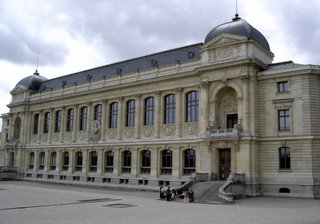
The Grand Gallery of Evolution was built in 1899 and restored in 1994. The permanent exhibit is concerned with the evolution of Life, the diversity of the living world and the evolution of living organisms in the history of Earth and Man.
The renovated museum was inaugurated by President François Mitterrand on Tuesday, June 21, 1994.
The Grande Galerie de l'Evolution is open everyday (closed Tuesday and May 1st) from 10 a.m.-6 p.m.
Admission fees are 8 euros for adults and 6 euros for others with the same conditions on these tickets as the others.There is a boutique and café and coat-check.
Just before you reach the entrance of the Grand Gallery of Evolution you will come to the Galeries de Minéralogie et de Géologie. The Galleries of Mineralogy and Geology are open Monday-Friday (closed Tuesday) from 10 a.m.-5 p.m. and until 6 p.m. on Saturday and Sunday.
The admission fees are 6 euros for adults and 4 euros for others with the same conditions as the other tickets.
The Jardin des Plantes is an expansive garden of beauty and education.
Return to Top of Jardin des Plantes
Private Tours
| Paris Introduction Tour | Paris Islands Tour | Paris Passages Tour |
| Trocodero-Eiffel-Invalides | Marais Tour | Montmartre Tour |
| Latin Quarter Tour | Paris Markets Tour | Paris Churches Tour |
Booking.com
New! Comments
Have your say about what you just read! Leave me a comment in the box below.